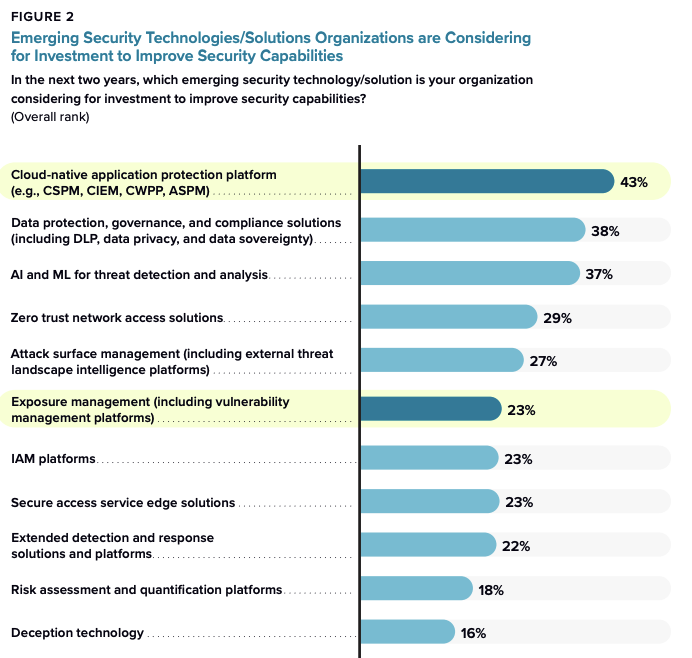クラウド セキュリティの迷路を解き明かす地図: 統合クラウドセキュリティソリューションをエクスポージャー管理アプローチの一部とする

IDC のホワイトペーパー「クラウドセキュリティとエクスポージャー管理を統合したリスク削減戦略」の中で当社が注目したポイントを紹介します。このホワイトペーパーでは、アラート主導の事後対応型モデルから事前対応型のエクスポージャー管理戦略へと移行することによって複雑なマルチクラウド環境を管理できるように、CNAPP がセキュリティチームをどう支援するかが説明されています。
組織の急速なクラウド展開によって、セキュリティをとりまく状況が複雑で厄介なものになっているため、多くの場合、セキュリティチームは非生産的な事後対応のサイクルに陥っています。 断片的なツールの寄せ集めから次々と発生する膨大なアラートに追われる中、拡大し続けるアタックサーフェスの全体像を把握するのに苦労しています。その結果、どの脅威が最も重大なのかを優先付けることが常に課題となっています。
このような状況に心当たりがある人は、あなただけではありません。 従来のセキュリティモデルでは、動的でマルチクラウドにまたがる環境を管理するには限界があります。朗報があります。それは、エクスポージャー管理戦略の一部として、統合型のクラウドネイティブアプリケーション保護プラットフォーム (CNAPP) を活用するという新たな道です。
Tenable が出資した、業界調査会社 IDC による「Bridging Cloud Security and Exposure Management for Unified Risk Reduction (クラウドセキュリティとエクスポージャー管理を統合したリスク削減戦略)」と題した新しいホワイトペーパーは、CNAPP がクラウドセキュリティにどのような変革的アプローチを提供するかに光を当てています。
「このような環境では、クラウドセキュリティはもはや孤立した機能であってはなりません。CNAPP はエンタープライズセキュリティ戦略における重要な進化であり、チームがクラウドスタックのあらゆるレイヤーを保護すると同時に、可視性を統合し、対応を加速し、大規模にリスクを低減することを可能にします」と IDC のホワイトペーパーには記されています。
このブログでは、ますます巧妙化し、攻撃性を増すサイバー攻撃に対抗するために、エクスポージャー管理を組み込んだ CNAPP 中心の戦略が不可欠になってきている理由など、このホワイトペーパーから得られた主要なインサイトを概説します。
CNAPP ソリューション: 防御の一元化
CNAPP は大きな変革をもたらします。 IDC のホワイトペーパーが示すように、CNAPP は複数のセキュリティ領域を統合し、単一のプラットフォームとして提供します。言い換えれば、クラウドセキュリティにおける「司令塔」のような存在であり、次のような機能を一元的に備えています。
- 設定ミスの特定と修正 (クラウドセキュリティポスチャー管理: CSPM)
- 仮想マシン、コンテナ、サーバーレス環境の保護 (クラウドワークロード保護: CWP)
- アイデンティティと権限の管理 (クラウドインフラ権限管理: CIEM)
- クラウドデータの保護 (データセキュリティポスチャー管理: DSPM)
- クラウド AI システムの保護 (人工知能セキュリティポスチャー管理: AI-SPM)
- Kubernetes 環境の保護 (Kubernetes セキュリティポスチャー管理: KSPM)
- インフラのコード化スキャンを含む、コードからクラウドまでの脆弱性管理
CNAPP によって、これらの異なるセキュリティ機能間のサイロが解消されることで、クラウド資産全体を包括的に把握できるようになると IDC は説明しています。 CNAPP では、例えばある領域の設定ミスが、機密データにアクセスするために過剰な特権を持つアイデンティティに悪用される可能性など、異なる種類のリスク間の関連性を確認することができます。 このような文脈を踏まえた知見は、事後対応型から事前対応型のセキュリティ態勢に移行する上で極めて重要です。
これらの機能は、エクスポージャー管理の重視とともに、真に効果的な CNAPP と基本的な CNAPP を分けるものとなります。 「意思決定者には、エクスポージャー管理プラットフォームと効果的に統合し、一元的な可視性を提供し、優先順位付けされたリスク軽減を促進する CNAPP ソリューションを検討することを推奨します」と IDC のホワイトペーパーには記されています。
Tenable では、エクスポージャー管理を、最も重大なサイバーリスクを先行的に評価して修正するために使用できる、サイバーセキュリティに対する戦略的なビジネス中心型のアプローチであると定義しています。 当社の見解では、エクスポージャー管理は、ビジネスとリスクの文脈を脅威インテリジェンスと統合するという点で、従来の脆弱性管理を超越しています。 そうすることで、リスクを低減し、アタックサーフェスを縮小しながら、脆弱性を明らかにし、優先順位をつけて解決することができます。
実際、IDC による以下のグラフが示すように、CNAPP とエクスポージャー管理は、組織のセキュリティ機能を向上させるための新たなテクノロジーやソリューションを探しているセキュリティ管理者から非常に注目されています。

(回答者 = 600 人、出典: IDC の AP セキュリティ調査、2024年。 注記:これは IDC によるシンジケート調査です。 回答者は、管理職以上の専門家です。)
強固なクラウドセキュリティ態勢への道
IDC のホワイトペーパーによるメッセージは明確です。CNAPP 中心のアプローチこそが、クラウドセキュリティの未来です。 CNAPP は単にツールを統合するだけではなく、 クラウドにおけるリスク管理の方法を根本的に強化します。 CNAPP は、攻撃者の先を行くために必要な可視性、文脈、実用的なインサイトを提供することによってサイバーセキュリティチームを強化します。
「クラウドや環境にとらわれない CNAPP 戦略、特にエクスポージャー管理を組み込んだ CNAPP 戦略は、プラットフォーム間のシームレスな統合を促進することで、組織が制御を維持し、リソースの利用を最適化し、セキュリティ態勢を強化できるようサポートします」と、IDC のホワイトペーパーには記されています。
CISO の役割が進化しているのに加え、セキュリティの優先順位が自動化、エンドツーエンドの可視化、リアルタイムの脅威管理へとシフトしているため、CISO にとってもメリットがあります。
「クラウドセキュリティを含めたエクスポージャー管理は、潜在的なセキュリティギャップに関する文脈に基づくリスクインサイトを提供し、タイムリーな介入を促進するため、これらの優先事項と合致します」と IDC のホワイトペーパーには記載されています。
詳細を確認するには
IDC のホワイトペーパー全文では、これらすべてのトピックについてさらに詳しく説明し、 以下の情報を提供しています。
- クラウドセキュリティの現状についての包括的な考察
- 最新の CNAPP 機能の詳細
- ソリューションに何を求めるべきかについてのガイド
また、Tenable Cloud Security CNAPP がどのように Tenable One サイバーエクスポージャー管理プラットフォームと統合されているかに焦点を当て、クラウドセキュリティに対する Tenable のアプローチを詳しく紹介しています。
IDC によると、Tenable Cloud Security と Tenable One の組み合わせは、「クラウド環境とハイブリッド環境全体の盲点をなくすものです」。
IDC のホワイトペーパーには、「この統合によって、ステークホルダーは、より広範な IT とクラウドの環境の中でクラウドのリスクを把握し、軽減できるようになります」と記されています。
クラウドセキュリティの成熟への道のりは困難ですが、エクスポージャー管理を統合した CNAPP 中心のアプローチを採用することで達成することができます。
クラウドの複雑さに振り回され、脆弱性を抱えたままにしてはいけません。全体像を把握し、より安全なクラウドへのロードマップを描き始めるために、IDC のホワイトペーパー「クラウドセキュリティとエクスポージャー管理を統合したリスク削減戦略」をぜひダウンロードしてください。
- Cloud
- Exposure Management



